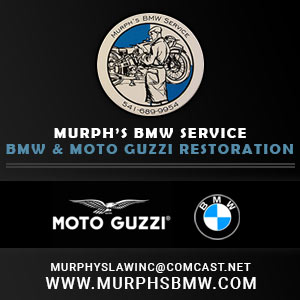1995 R100 Mystic L/H side vibration
Left side vibration 1995 R100 Mystic,,,,L/H mirror and L/H foot peg present most prevalent evidence; images in L/H mirror show significant vibration,,,,no such vibration images in R/H mirror, L/H foot peg and noticeably higher vibration buzz as compared to R/H foot peg.
Bike has “bar backs” installed and has foot peg lowers installed.
Process of elimination checks made;
Timing at idle and advanced to 3500-4000k rpm checks spot on with timing light
Intake and exhaust valves clearances (both sides), checked good IAW manual
Carbs balanced with Carbtune meter (at idle, 1500k rpm, and 3500k rpm)
Checked torque on all bolts/nuts on front suspension/brakes/triple tree/handle bars/mirrors/engine mounts/foot pegs/center stand/side stand/exhaust nuts and brackets,,,,all nuts and bolts checked fine
Bike has bar end weights with R/H weight acting also as a throttle lock,,,,swapped bar ends,,,no change
There is the more or less general/typical vibration around 3250-3750 RPM present and noticeable in both mirrors and foot pegs
Performed the following test as recommended on MOA forum: coasted down steep hill in gear with engine running but closed throttle to see if it shakes badly (indicating the problem would not be ignition or carbs but rather mechanical in nature,,,,this test didn’t really alter the symptoms, test was conducted in 1st, 2nd and 3rd gear)
L/H Vibration does decrease significantly at pretty much any speed and gear when clutch lever is pulled in.
So my question(s) are if it was transmission to engine issue or something related to clutch or flywheel it why would affect just the L/H side?,,,,or is the vibration related something else?
Any ideas/input/advice appreciated
TIA
Your approach seems logical, but I've never come across anything like that.
Owning an old Airhead is easy.
Keeping an old Airhead running great is the true test.
One would think that a vibration would be a vibration. How could it “favor” one side. Someone smarter than I will probably shoot holes in this, but I would be curious to compare compression between cylinders. Don’t ask why … cuz, I have no idea.
Not to drift too far off the track here, but my experience with a significant deviation in compression from one side to the other manifests as a challenge in getting the carbs balanced. I mean like you can't get the carbs in balance. Having said that, I like the idea of a compression check. It's easy and lets you cross one possibility off the list.
"L/H Vibration does decrease significantly at pretty much any speed and gear when clutch lever is pulled in."
This would direct me to suspect that the issue lies downstream from the clutch. My "wild ass guess" would be to look in to the swing arm bearings. Since the mono-shock is located on the right side, is it possible that the load carried by the swing arm bearings is un-even? Also, when the clutch lever is pulled and the bike is coasting, the front / rear weight distribution changes.
The only Mono-shock airhead that is have owned and ridden was a 1988 R100 RS. I never had an issue like that. The difference being that a Mystic has a para-lever drive shaft and swing arm. These are known to be a weak link on a GS, with the longer suspension travel, but a weakness is a weakness.
Maybe you could put the bike on the center stand and bind the front suspension down and the shake the rear wheel, gripping it at the top and bottom. Visualize attempting to detect a twisting effect in the rear suspension. Maybe try that test with the shock connected and then removed to look for deviations. The drive line should be rock solid. How many miles?
former Airmarshal, IL.
@4949 I hadn't thought of the step of checking compression; I'll give that a shot (at east that way I'll know what the baseline numbers are)
Thank you
@8053 Thank you, your feedback is helpful. I have a small lift I can put the bike on to try that procedure. One thing I hadn't mentioned in my first post (or thought of) was that this bike has an aftermarket rear shock, a Wilburs adjustable shock. I need to do some research on that topic. The bike has just a bit over 18,000 miles on it. thank you again
18K miles is a pretty low number. I have to wonder why a pricey aftermarket shock would be installed on a low mileage bike. Is there any known history on the bike? I have 2 bikes with a known history of ownership and 1 that the history is un-knowable. We seldom get the full story on a bike with any more than 2 owners. Another thing I might check if it were my bike would be to peel back the driveshaft boot and confirm that the drive shaft flange is tight to the transmission output flange, looking for loose or missing bolts.
former Airmarshal, IL.
Posted by: @805318K miles is a pretty low number. I have to wonder why a pricey aftermarket shock would be installed on a low mileage bike.
Because the shocks are gas-filled. The gas is used to control the behavior of the hydraulic oil. Once the seals get old and hard, the gas all leaks out leaving a poorly performing shock. So Age, not Mileage, is the determining factor.
• This is a reach, but I had a single-sided that had the rear wheel bearings go out. You might do a push-pull test on the wheel from the side. While facing the end of the axle, grab the wheel at 2 places 180° apart. Push-pull to detect any play. None (zero) is the only measurement permissible.
Owning an old Airhead is easy.
Keeping an old Airhead running great is the true test.
@wobbly Thank you for your input, much appreciated. In the course of doing a few of the tasks mentioned earlier I did check the rear wheel "play",,,there was none I'm happy to report,,,I checked that with and without the rear shock attached.
@8053 Thank you for your reply and continuing interest, I appreciate it the feedback.
So, the things I've checked so far after my original post; the compression is virtually equal on both sides at 145 PSI,,,that sounds pretty good to me; I checked the rear wheel "play" with the rear shock attached and unattached,,,felt solid to me. The bolts between the forward swing arm flange and gear box are tight as well.
I'll next apply (or attempt to) apply grease to both swing arm bearing receptacles.
thanks again for your help, much appreciated.
Wild A Guess-torque of engine mounting bolts. I don't have spec on anything that new.
@1872 Thank you for your input. I had, earlier, checked the torque/tightness of just about every nut and bolt I could; frame to engine bolts/nuts; suspension components, gear box to engine, exhaust components, center stand, side stand, brakes, forks, wheels, triple tree, drive shaft to gear box, swing arm, handle bar, foot pegs, handle bar perches, mirrors, the heads are torqued properly, the valves are adjusted properly, the carbs are balanced,,,,etc. What is so puzzling to me is the vibration is so very much more evident on the left side as compared to the right side......an image in the right side rear view mirror is easily identified (for example, my right elbow image is stationary in the mirror as are objects way further behind me), while in the left side mirror it's anybody's guess as to what the image really is.
@kevin-schilling I'm wondering if it simply isn't the way that one mirror reacts or behaves in the general vibration environment.
Owning an old Airhead is easy.
Keeping an old Airhead running great is the true test.
@wobbly Hmmmm, well, I certainly hadn't thought of that, thank you. I have a couple of other sets of mirrors I can try. No harm in trying, right?
Exactly. As I prep my RS and choose from available OEM mirrors, I'm finding there are lots of differences.
Owning an old Airhead is easy.
Keeping an old Airhead running great is the true test.
- 27 Forums
- 1,900 Topics
- 10.8 K Posts
- 3 Online
- 5,936 Members





